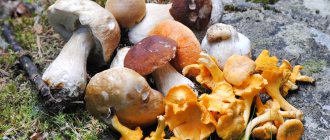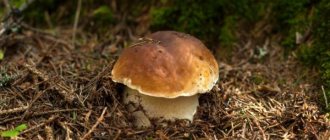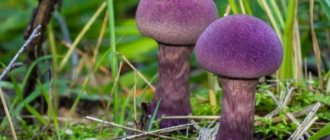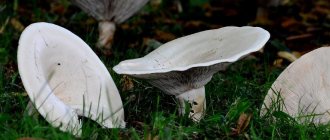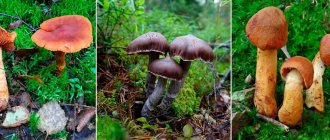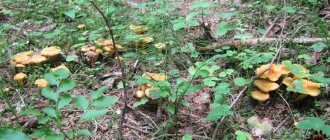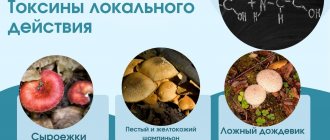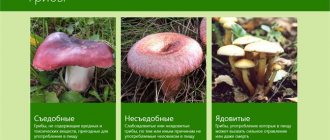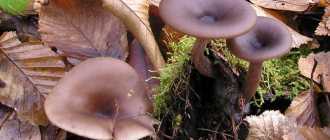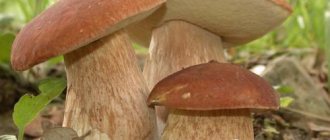Characteristics of edible mushrooms
Mushrooms are a popular food product that people have known about since ancient times. Today, the fruits of heterotrophic organisms continue to be actively used as food, both as a main dish and as an additional ingredient. They are boiled, fried, stewed and even salted in order to be able to enjoy the delicate taste of the product throughout the year, and not just during the “quiet hunting” season.
This popularity of fruits is explained by their high nutritional value. Despite the fact that such organisms cannot independently produce useful microelements, they easily absorb them from the environment. For this reason, they are rich in potassium, iron, magnesium, zinc and other beneficial microelements, including B vitamins. But in order to eat mushrooms without danger or harm to your health, you need to know which types are edible.
Features of edible representatives of the heterotrophic kingdom:
- They have a rich taste, even after heat treatment.
- Pleasant, not pungent smell.
- No bitterness.
- Do not contain harmful and toxic substances.
There are no precise criteria by which one can determine the relationship of a species to a particular group. Therefore, when going to the forest, you need to know the external signs of edible mushrooms, so that a dish dangerous to health and life does not end up on your plates.
On a note! As a rule, edible representatives of the kingdom have a calm color, without bright inclusions. Most often, there are no rings on the mushroom stems.
But as you know, any rule has exceptions, so when harvesting, you should not rely solely on average indicators. For example, the poisonous pale grebe has a calm color and light flesh, but this does not at all mean that it is edible.
When do they appear?
The first boletus appears in coniferous forests at the very beginning of summer. The most productive month is considered to be the whole of June and the beginning of July. As a rule, they grow in three weeks, and the season begins to wind down in mid-August or early September. If you plan to collect a significant amount, you need to get out into the forest at the very beginning of August. But provided that the summer was hot. It is at this time that the sun's warmth and weather are favorable for mushrooms to actively grow.
To get a good harvest of boletus, you will need a lot of sunlight. It is also worth considering that these mushrooms do not like moisture at all. That is why they live well in these soils.
They are easy to find in fields and meadows. In addition, these mushrooms, unlike others, love sunlight very much. Therefore, if the summer turns out to be gray and rainy, then you cannot expect a good harvest in August.
In addition, they feel very uncomfortable in the dark. However, you also shouldn’t overdo it with sunlight. If the rays of the sun are very scorching, then growth and development will be slow.
Important! Butterworts grow actively until the first frost.
Classification according to the structure of the hymenophore
All mushrooms, regardless of the amount of harmful substances in their composition, are divided into groups according to the type of structure, external characteristics and a number of other criteria. Thus, according to the structure of the hymenophore, which is the part of the fruiting body that carries spores, the following types of organisms are distinguished:
- Lamellar. The hymenophore is represented by thin plates extending from the center of the cap to its edges. There are disputes between them.
- Marsupials, or smooth. The stem and cap of this species have practically no differences, and the spores are in a special bag, from which the group got its name.
- Tubular. Representatives of the group have so-called tubes under their caps, located perpendicularly. It is in these smallest parts that fungal spores are located.
- Folded. The spores are located in radical folds or deep wrinkles, which makes this group similar to the lamellar species.
Cap mushrooms, as a rule, have a lamellar hymenophore, so it is most likely to encounter a similar type during a “quiet hunt”. These include such popular representatives as champignons, russula and milk mushrooms. Even the well-known fly agaric also has a lamellar hymenophore. But the most expensive mushroom, the truffle, belongs to the group of marsupials. Porcini and boletus mushrooms are a type of fruit with a tubular hymenophore.
Edibility table
As you know, not all mushrooms can be eaten without harm to health, despite all their nutritional value. This is due to the fact that representatives of the kingdom contain substances that are toxic to the human body.
However, in some fruiting bodies the concentration of toxins is minimal, which makes them safe and edible for humans. It is based on the amount of toxic substances in the fruiting body that mushrooms were divided into 3 groups:
| Group name | Characteristics | Representatives |
| Edible | Pleasant taste and aroma. They do not cause poisoning, regardless of the method of preparation. | Champignon, porcini mushroom, boletus, milk mushroom, chanterelles, saffron milk cap. |
| Conditionally edible | The amount of harmful substances in fruits affects their taste. Representatives have a bitter taste and a sharp, sometimes unpleasant odor. Their use is allowed only after prolonged cooking (more than 60 minutes) with preliminary soaking in cold water. Poor heat treatment of mushrooms can cause poisoning. | Svinushki, volushki, rows, valui, russula, black milk mushrooms. |
| Poisonous | They contain a large amount of toxic and poisonous substances that do not decompose under prolonged exposure to high temperatures. Absolutely not edible. Their use can lead to serious disruptions in the functioning of the body and even death. | Pale toadstool, satanic mushroom, false honey fungus, fly agaric. |
Knowing what type a particular representative belongs to will help you avoid poisoning, which often leads to fatal consequences.
Where do boletus grow?
Most boletus grows in the temperate zone, as well as in the European part of the country. They are widespread in Asian countries, where they are considered a real delicacy.
The distribution in this territory is observed in much more modest quantities than in Russia. This is a rare mushroom that is often found in Australia and Africa.
Butterflies are very fond of coniferous or mixed forests. Very often they form mycorrhiza with spruce or old pine. In addition to Russia, they are found in large numbers in Belarus and Ukraine.
Despite the fall of cones and needles, these mushrooms have perfectly adapted to life in such conditions. They are also present in deciduous forests, but in much smaller quantities. The fact is that the crown of spruce and coniferous forests in general protects them well from wind and cold, but at the same time lets in the sun's rays, which are so necessary for growth.
If you intend to collect boletus in a mixed forest, then prepare for the fact that the harvest will be relatively small. Therefore, it is better to immediately go to coniferous forests.
These mushrooms can be found in clearings, meadows and fields. Here they will survive thanks to long grass, as well as direct sunlight that hits the cap directly.
Butterfly does not like deciduous trees, because they form a special composition of the soil around them, which does not have the best effect on growth and development; a difference is felt with coniferous forests.
Important! You can find boletus near old wooden cottages. Country crops need to be checked for the absence of poisons.
Nutritional value of forest fruits and identification of categories
In terms of the amount of nutrients they contain, mushrooms are significantly superior to other popular foods. It is believed that the chemical composition of the fruiting bodies resembles a mix of vegetables and meat, which makes it possible to classify mushrooms as products with high nutritional value.
Good to know!
Regular consumption of fruits allows you to saturate the body with all the micronutrients that are necessary for normal functioning.
The raw product contains:
- Proteins – 2-5%.
- Fats – up to 1.5%.
- Carbohydrates – up to 4%.
- Water – about 90% of the mass, depending on the type.
- Cellulose.
- Ash.
- Essential and non-essential amino acids.
- Essential oils.
- Organic acids.
- Enzymes.
- Vitamin A, C, PP, E, D and group B.
- Microelements (potassium, magnesium, phosphorus, iron, zinc and others).
The presence of such a nutritious product in the diet has a beneficial effect on the cardiovascular, musculoskeletal and nervous systems. However, despite all the usefulness of forest fruits, they are classified as “heavy” food due to the presence of chitin.
To shorten the digestion period and speed up the absorption process, the product is additionally boiled or crushed before the main type of processing. People with gastrointestinal diseases are recommended to consume exclusively mushroom caps, since they contain significantly less coarse fiber than the stems.
It is worth considering that representatives of each species have their own unique chemical composition. Therefore, the opinion that all edible mushrooms are equally useful is erroneous. According to the amount of useful substances in the composition of the fruiting body and its taste, edible representatives of the kingdom are divided into 4 categories.
What mushrooms belong to the first category
The first or highest category includes fruits with high nutritional value and taste. They can be safely eaten even raw. They are considered a real storehouse of useful substances and vitamins, which are almost completely absorbed by the human body.
This category includes:
- The breast is real.
- Porcini.
- The fox is real.
- Camelina pine and spruce.
Despite the fact that the classification is conditional and is practically not used in the modern world, the amount of nutrients contained in the species of the first category is not questioned.
List of varieties from the second category
The taste of forest fruits from the second category is described as good. This difference in taste and aroma is explained by the chemical composition of the product. Species from the second category contain fewer nutrients and essential oils, which give mushrooms a pleasant taste and smell.
The second category includes:
- The breast is golden yellow, oak and grey-purple.
- Champignon.
- The butter dish is summery and grainy.
- Boletus.
- Boletus.
- Chestnut mushroom.
- Oiler is regular, late, granular and summer.
- Dubovik speckled and common.
- Russula is white.
- Loading.
Representatives of this group will be an excellent addition to many dishes. In addition, in European countries, many of them belong to the highest category of fruits, depending on the taste preferences of local residents and the region of growth.
Taste qualities of the third and fourth categories
Representatives of the third category belong to edible mushrooms with an average taste and similar nutritional value. These include:
- Chanterelles are light, yellowing and black.
- The breast is aspen and black.
- The honey fungus is real.
- Valuy.
- The flywheel is variegated, yellow-brown and green.
- Boletus.
- Volnushka pink and white.
- Polish mushroom.
- Morel ordinary and conical.
- Russula.
- Reshetnik.
These mushrooms contain small amounts of nutrients, which makes them less beneficial for the human body. However, this does not at all reduce their popularity, and many representatives of category 3 are in demand among lovers of “quiet hunting”.
Fruits of the fourth category are considered less nutritious and tasty. Such mushrooms have a bitter aftertaste, which sometimes remains even after prolonged cooking. Among them:
- talkers;
- oyster mushroom;
- loading black;
- raincoats;
- red and velvet moss;
- summer and meadow honey fungus;
- hedgehogs;
- goats;
- rows.
You may be interested in: How do edible talkers differ from false mushrooms? How many days after rain do mushrooms grow? Bitter mushroom: photo and detailed description
Surprisingly, even the famous fly agaric is classified as a conditionally edible mushroom, since its toxins disintegrate under the influence of high temperatures.
However, experienced mushroom pickers and doctors do not recommend consuming it even after prolonged heat treatment.
Despite all the usefulness and nutritional value of mushrooms, they must be introduced into the diet carefully. You should not give preference to mushroom dishes too often, as they overload the digestive system and lead to exacerbation of chronic gastrointestinal diseases. And when choosing a forest delicacy, it is worth finding out about its belonging to one or another category in terms of edibility and nutrient content.
Preview:
Author: Lazarev Igor Nikolaevich, biology teacher
Educational institution: municipal state educational institution “Shishlovskaya basic secondary school”
Lesson topic: Cap mushrooms. Edible and poisonous.
Laboratory work “Recognition of edible and poisonous mushrooms”
– Familiarize yourself with the structural features and feeding method of cap mushrooms.
- teach to recognize and describe the objects being studied, using an illustrative series of electronic manuals and a textbook, as well as edible and poisonous mushrooms.
-develop concepts about the diversity of living organisms;
-continue the formation of basic biological concepts, elements of creative activity through immersion in solving problematic issues and involving schoolchildren in independent work.
-development of cognitive interest in the subject.
-formation of a creative attitude to the application of knowledge, vision of natural objects in the surrounding world;
– stimulating the desire for intellectual development;
- formation of a feeling of love for nature and maintaining one’s health.
- Organizing time.
- Homework survey
Children are invited to take cards from the table that depict mushrooms belonging to different groups. Children are asked to go to stations, depending on the card they receive. Station 1 – molds, station 2 – yeast, station 3 – fungi – parasites. After a short discussion, each group gives a description of the mushrooms.
- Learning new material
We have studied molds, yeasts and parasitic fungi. What other mushrooms could there be?
Children can name representatives of cap mushrooms
Such mushrooms are called cap mushrooms and in today’s lesson we will get acquainted with the structure and vital functions of cap mushrooms
In everyday life, we call mushrooms their fruiting bodies. In most edible mushrooms, the fruiting body is formed by a cap and a stalk. Hence their name.
If you slightly dig up the soil in the place where the mushroom was removed, you can find thin branching white threads - mycelium. The cells of the mycelium of cap mushrooms are often binucleate and do not contain plastids. The mycelium is the main part of every mushroom. Fruiting bodies develop on it. The cap and stem consist of mycelium threads tightly adjacent to each other. In the stem, all the threads are the same, and in the cap they form two layers - the upper one, covered with skin, colored with different pigments, and the lower one. In some mushrooms it is represented by numerous tubes, in others by numerous plates.
Based on the structure of the lower layer, mushrooms are divided into lamellar and tubular. (slide 2)
In the tubes or on the plates of the cap, special cells are formed - spores, with the help of which mushrooms reproduce. Once in moist, humus-rich soil, fungal spores germinate and mycelium threads develop from them. (Slide 3) A mycelium arising from a single spore can form fruiting bodies only in rare cases. In most species of fungi, fruiting bodies develop on myceliums formed by fused cells of filaments originating from different spores. Therefore, the cells of such a mycelium are binuclear. The mycelium grows slowly, and only after accumulating reserves of nutrients does it form fruiting bodies.
Many of you have collected mushrooms with adults and noticed that many mushrooms can be found under certain trees: boletus mushrooms are most often found in birch forests, porcini mushrooms are found near birch, pine, spruce and oak trees, boletus mushrooms are found in aspen forests. This is explained by the fact that a close connection is established between certain types of trees and mushrooms, beneficial to both one and the other organism. (Slide 4) Let's remember where we met the concept of symbiosis. (, nodule bacteria).
We looked at lamellar and cap mushrooms. What other groups can mushrooms be divided into? (edible and poisonous)
We will study edible and poisonous mushrooms during laboratory work. Open your notebooks, write down the number
Laboratory work: “Recognition of edible and poisonous mushrooms”
Purpose of the work: learn to recognize edible and poisonous mushrooms.
Equipment: projector, models of cap mushrooms.
Slide (5) let's look at the slide of two representatives of cap mushrooms:
Champignons and toadstool. Pale toadstools are similar in appearance to champignons, only the underside of their cap is greenish-white, unlike the pink of the champignon. (slide 6)
Chanterelles and false chanterelles (slide . False chanterelles are also similar to edible chanterelles, but their caps are smooth reddish-orange rather than light yellow, and white juice is released from the broken cap of a false chanterelle. (slide 9)
False honey mushrooms and edible honey mushrooms. Edible honey mushrooms have a ring of film on the stem, while false mushrooms do not have such a film and the plates under the cap are greenish. (slide 10,11)
Gall and porcini mushrooms. The gall mushroom looks like a white one, but the upper part of its stem is covered with a dark mesh pattern, and the flesh turns red at the break (slide 12,13)
And the last representative of poisonous cap mushrooms, which you all know (slide 14)
What conclusion can we draw after completing laboratory work? (we learned to recognize edible and poisonous mushrooms; many mushrooms are similar in appearance)


